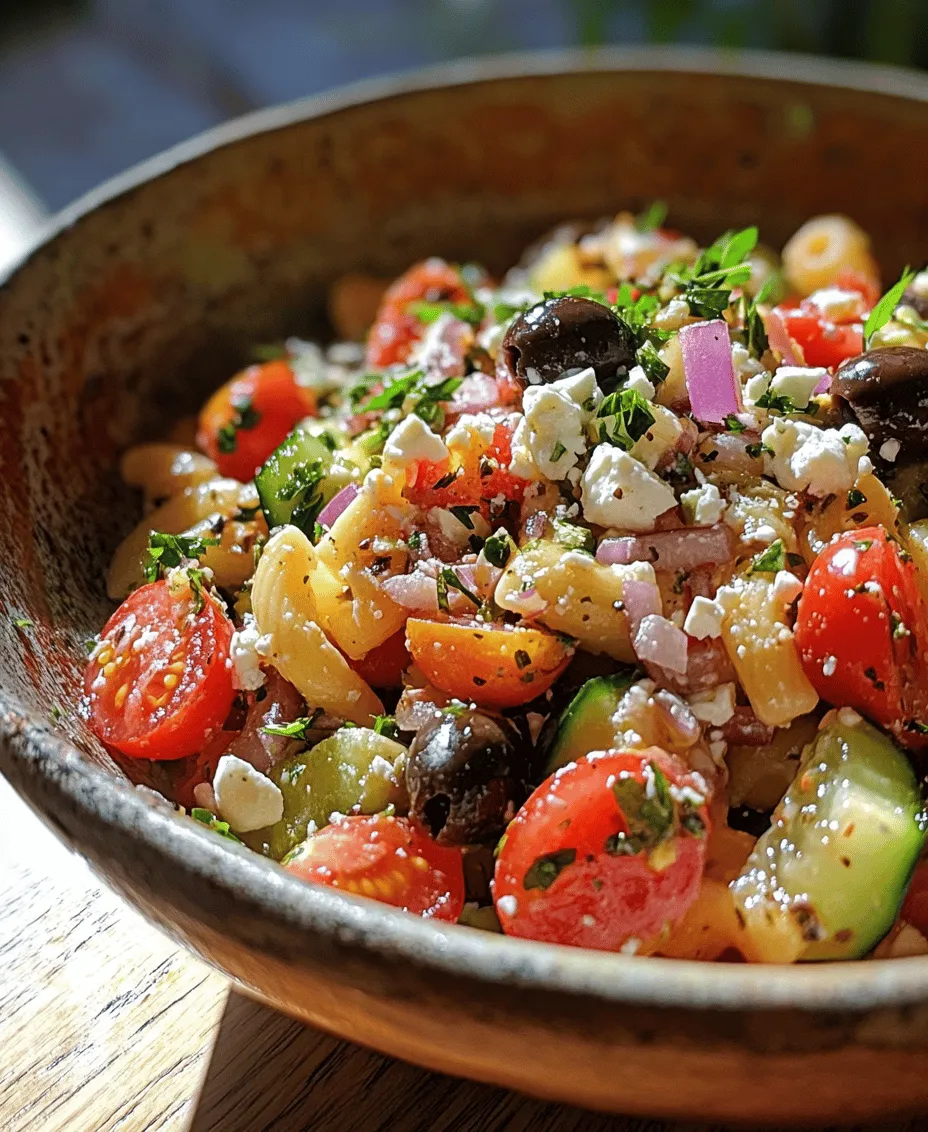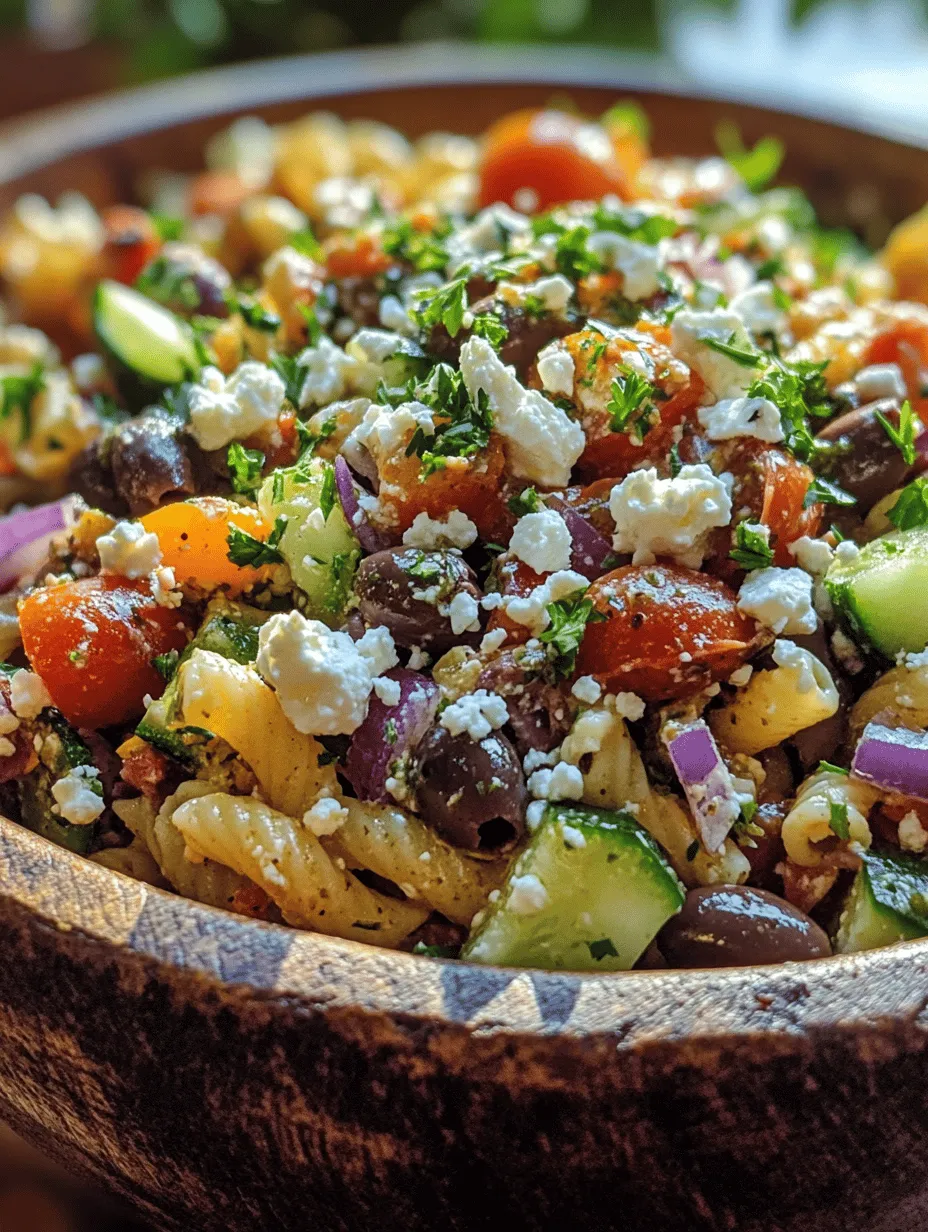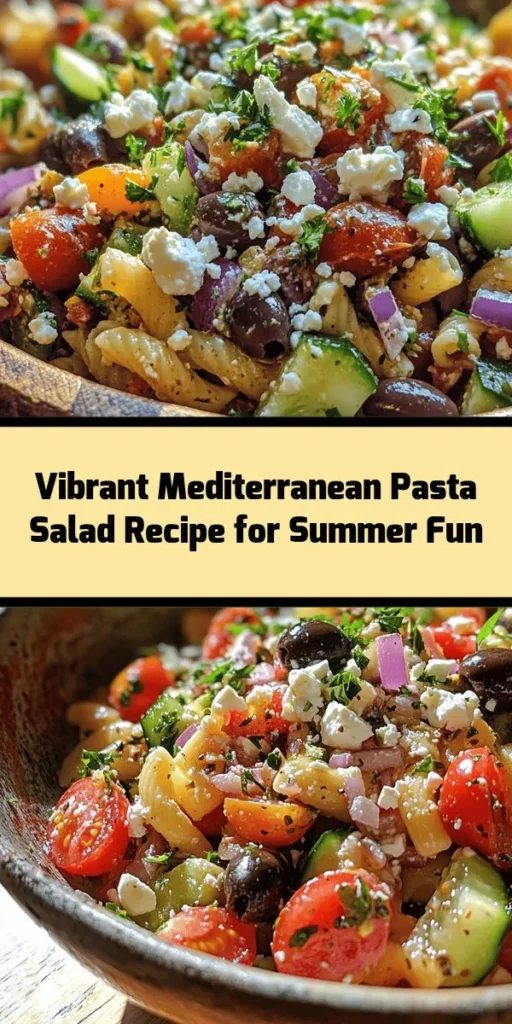In the realm of culinary delights, few dishes embody the spirit of summer as vibrantly as a Mediterranean pasta salad. This Colorful Mediterranean Pasta Salad is not only visually appealing but also packed with nutritious ingredients, making it a perfect choice for gatherings or a light meal. With its combination of fresh vegetables, tangy feta cheese, and a zesty dressing, this dish encapsulates the flavors of the Mediterranean region. In this article, we will explore the recipe in detail, discuss its health benefits, and delve into variations that can suit any palate.
The Allure of Mediterranean Cuisine
Understanding Mediterranean Cuisine
Mediterranean cuisine is celebrated worldwide for its vibrant flavors and emphasis on fresh, wholesome ingredients. Characterized by the use of fruits, vegetables, whole grains, nuts, and legumes, this culinary style is synonymous with health and vitality. The Mediterranean diet is often lauded for its numerous health benefits, including heart health, weight management, and lower rates of chronic diseases.
One of the hallmarks of Mediterranean flavors is the balance between savory, sweet, and tangy elements. Dishes often incorporate herbs and spices that enhance natural flavors without overwhelming them. Olive oil, a staple in Mediterranean cooking, is revered not only for its taste but also for its health benefits, including heart-healthy fats and antioxidants.
Pasta salads, in particular, hold a special place in Mediterranean cuisine. They are versatile, easy to prepare, and can be enjoyed warm or cold. Each Mediterranean country boasts its unique take on pasta salads, incorporating local ingredients and flavors that reflect their culinary heritage. This Colorful Mediterranean Pasta Salad is a delightful representation of these traditions, bringing together a variety of textures and tastes that make it a standout dish.
Health Benefits of Mediterranean Ingredients
The health benefits of Mediterranean pasta salads are plentiful, thanks to the wholesome ingredients that comprise them. Pasta salads typically feature a combination of vegetables, healthy fats, and proteins, providing a balanced meal in a bowl.
– Nutritional Profile of Pasta Salads: A well-prepared pasta salad can be a nutritious option, offering a variety of vitamins, minerals, and fiber. The vegetables contribute essential nutrients like vitamin C, potassium, and antioxidants, while the pasta provides carbohydrates for energy.
– Benefits of Olive Oil, Vegetables, and Feta Cheese: Extra virgin olive oil is rich in monounsaturated fats, which can help reduce bad cholesterol levels and lower the risk of heart disease. The use of fresh vegetables like cucumbers and tomatoes adds hydration and crunch, while feta cheese not only enhances the flavor but also provides a source of protein and calcium.
– Role of the Mediterranean Diet in Promoting Health: The Mediterranean diet, which emphasizes whole foods and limits processed ingredients, has been linked to reduced risks of various health issues, including obesity, diabetes, and cardiovascular diseases. Incorporating dishes like this Colorful Mediterranean Pasta Salad into your diet can be a delicious way to adopt healthier eating habits.
Ingredients Breakdown for Colorful Mediterranean Pasta Salad
To create a delicious Colorful Mediterranean Pasta Salad, it’s essential to select the right ingredients. Each component plays a vital role in delivering flavor, texture, and nutritional value. Here’s a breakdown of the key ingredients needed for this delightful dish.
Essential Components of the Salad
– Elbow Macaroni: While any pasta can be used, elbow macaroni is a versatile choice that holds up well in salads. Its small shape allows it to catch the dressing and blend seamlessly with other ingredients.
– Cherry Tomatoes: Sweet and bursting with flavor, cherry tomatoes add a pop of color and natural sweetness to the salad. They are also rich in antioxidants, making them a healthy addition.
– Cucumbers: With their crisp texture and high water content, cucumbers provide a refreshing crunch that balances the richness of other ingredients. They are low in calories and hydrating, making them an ideal choice for summer salads.
– Red Onion: Finely chopped red onion contributes a sharp, tangy flavor that adds depth to the salad. When soaked in the dressing, the onions mellow slightly, becoming more palatable while still providing a flavorful punch.
– Black Olives: Offering a salty richness, black olives are a staple in Mediterranean cuisine. They add complexity to the salad and contrast beautifully with the other flavors.
– Feta Cheese: Crumbled feta cheese brings a creamy texture and tangy flavor to the salad. It’s an essential ingredient that ties the dish together, enriching the overall taste experience.
– Fresh Parsley: Chopped fresh parsley adds a burst of aromatic freshness, enhancing the salad’s visual appeal while providing a mild, herbal note.
The Dressing: Key to Flavor
The dressing is what elevates the Colorful Mediterranean Pasta Salad from ordinary to extraordinary. A well-balanced dressing will enhance the flavors of the ingredients while contributing its own unique character. Here are the key components of the dressing:
– Extra Virgin Olive Oil: Known for its health benefits and rich flavor, extra virgin olive oil serves as the base of the dressing. It helps to coat the pasta and vegetables, ensuring every bite is delicious.
– Red Wine Vinegar: This adds a tangy acidity that brightens the flavors of the salad. The vinegar balances the richness of the olive oil and feta, creating a harmonious blend.
– Dried Oregano: A classic herb in Mediterranean cooking, dried oregano adds an herbaceous note that complements the other ingredients beautifully. It infuses the dressing with a fragrant quality that enhances the overall flavor profile.
– Salt and Pepper: Essential seasonings, salt, and pepper help to elevate the flavors of the salad, ensuring that each bite is well-seasoned and satisfying.
Step-by-Step Instructions for Preparing the Salad
Now that we have explored the vibrant ingredients and the allure of Mediterranean cuisine, it’s time to dive into the preparation. Making a Colorful Mediterranean Pasta Salad is straightforward and rewarding. Follow these step-by-step instructions for a delicious dish that will impress your guests and satisfy your cravings.
Cooking the Pasta
1. Importance of Al Dente Cooking: Start by boiling a pot of salted water. Add the elbow macaroni and cook according to the package instructions until al dente. This means the pasta should be cooked through but still firm to the bite. Al dente pasta holds its shape better in salads and prevents it from becoming mushy.
2. Tips for Rinsing Pasta to Cool It Down: Once the pasta is cooked, drain it in a colander and rinse it under cold water. This stops the cooking process and cools down the pasta, making it more suitable for a salad. Rinsing also helps remove excess starch, preventing the noodles from sticking together.
Preparing the Vegetables
While the pasta is cooking, take the opportunity to prepare the vegetables:
1. Chop Cherry Tomatoes: Halve the cherry tomatoes and place them in a large mixing bowl. Their vibrant color will add visual appeal to the salad.
2. Dice Cucumbers: Peel and dice the cucumbers into bite-sized pieces. If you prefer, you can leave the skin on for added color and nutrients. Add them to the bowl with the tomatoes.
3. Slice Red Onion: Finely chop the red onion. If you find the flavor too strong, soak the chopped onion in cold water for 10 minutes to mellow its taste before adding it to the salad.
4. Add Black Olives: Slice the black olives and toss them into the bowl with the other vegetables. Their briny flavor will enhance the dish.
5. Crumble Feta Cheese: Finally, crumble the feta cheese and add it to the mixing bowl. The creaminess of the feta contrasts beautifully with the crisp vegetables and enhances the overall taste.
With the pasta cooked and the vegetables prepared, you’re ready to combine all the elements and create a vibrant Colorful Mediterranean Pasta Salad that is sure to become a favorite at any meal. Stay tuned for the next section, where we will cover the preparation of the dressing and the final assembly of this delightful dish.

Best Practices for Chopping and Mixing
When preparing a vibrant Mediterranean pasta salad, the way you chop and mix your ingredients can significantly affect the overall texture and presentation of the dish. Here are some best practices to keep in mind:
1. Use a Sharp Knife: A sharp knife allows for clean cuts and reduces bruising of delicate vegetables. This is particularly important for items like bell peppers, tomatoes, and fresh herbs, where you want to maintain their freshness and crispness.
2. Uniform Sizing: Aim to chop vegetables into uniform sizes. This ensures that they cook evenly if you decide to roast any, and also makes for a more aesthetically pleasing salad. For example, if you are using cucumbers, cut them into quarter-inch cubes to match the size of the tomatoes.
3. Chop Fresh Herbs Last: If you’re using fresh herbs, such as parsley or basil, chop them last. Their oils can oxidize quickly, leading to a loss of flavor. This practice will keep them vibrant and aromatic, enhancing the overall flavor of your salad.
4. Mixing Technique: When combining your chopped vegetables and pasta, use a gentle folding motion rather than vigorous stirring. This method prevents breaking the pasta and maintains the integrity of the vegetables.
How to Ensure Freshness in Vegetables
Fresh vegetables are the cornerstone of a delightful Mediterranean pasta salad. Here are some tips to ensure you’re incorporating the freshest ingredients:
1. Choose Seasonal Produce: Select vegetables that are in season for the best flavor and texture. Visit local farmers’ markets or grocery stores that emphasize seasonal produce. For summer, think about using ripe tomatoes, crisp cucumbers, and bell peppers.
2. Inspect for Quality: When selecting vegetables, look for bright colors and firm textures. Avoid any produce with soft spots or signs of wilting. For leafy greens, such as spinach or arugula, choose vibrant leaves without browning edges.
3. Storage Before Use: Store your vegetables in the refrigerator in a perforated bag to allow for airflow and to retain moisture. Use them within a few days of purchase for optimal freshness.
Mixing the Dressing
The dressing is crucial to elevating your Mediterranean pasta salad. Here’s how to create a well-balanced and flavorful dressing:
Techniques for Emulsifying Oil and Vinegar
1. Whisking Method: In a bowl, combine your balsamic vinegar (or another vinegar of choice) with your seasonings (like garlic, salt, and pepper). Gradually add the olive oil while whisking continuously. This helps to create an emulsion, where the oil and vinegar blend smoothly.
2. Shake it Up: Alternatively, you can place the ingredients in a jar with a tight-fitting lid. Shake vigorously for about 30 seconds until the dressing is well combined and emulsified.
Balancing Flavors in the Dressing
1. Taste as You Go: After mixing the dressing, taste it. If it’s too tart, add a touch more olive oil. If it lacks acidity, a bit more vinegar can enhance the flavor. This step is essential to achieving a dressing that complements your salad without overpowering it.
2. Herb Infusion: For added depth, consider incorporating fresh herbs like oregano or basil into the dressing. Let it sit for a few minutes before using to allow the flavors to meld.
Combining Ingredients for Optimal Flavor
Once your ingredients are prepared and your dressing is ready, it’s time to combine everything for the perfect Mediterranean pasta salad.
Methods for Tossing Ingredients Without Breaking Pasta
1. Layering Technique: Start by placing the cooked and cooled pasta in a large mixing bowl. Layer your chopped vegetables and herbs on top, followed by the dressing. This method minimizes the risk of breaking the pasta as you gently fold the ingredients together.
2. Gentle Folding: Use a large spatula or wooden spoon to fold the ingredients together. Start from the bottom and lift the pasta and vegetables over one another, rather than stirring vigorously. This method keeps the pasta intact and helps distribute the dressing evenly.
Importance of Letting Flavors Meld
1. Marinating Time: For the best flavor, let your pasta salad sit for at least 30 minutes after mixing. This resting period allows the pasta and vegetables to absorb the dressing and enhances the overall taste of the dish.
2. Refrigeration: If time permits, refrigerating the salad for a few hours or overnight can intensify the flavors even further, making it taste even better when served.
Finishing Touches: Cheese and Herbs
Adding cheese and herbs at the end can elevate your Mediterranean pasta salad:
Tips for Folding Ingredients Gently
1. Crumbled Cheese: If you’re using feta or goat cheese, crumble it over the salad just before serving. Gently fold it in to avoid breaking it down too much.
2. Fresh Herbs: Add freshly chopped herbs like parsley, basil, or mint at the end. This ensures they remain vibrant and flavorful, rather than wilting in the dressing.
Adjusting Seasoning to Taste
1. Final Taste Check: Before serving, do a final taste check on your pasta salad. Adjust the seasoning with additional salt, pepper, or a squeeze of lemon juice to brighten the flavors.
2. Presentation: Transfer the pasta salad to a serving bowl and sprinkle with additional herbs or cheese for an appealing presentation.
Serving Suggestions and Pairing Ideas
Best Ways to Serve Mediterranean Pasta Salad
1. Ideal Serving Temperature: Mediterranean pasta salad can be served cold or at room temperature. If you prefer it warm, serve it shortly after mixing, but keep in mind that the flavors develop better when allowed to chill.
2. Presentation Tips: Serve in a large, shallow bowl for a beautiful presentation. A few sprigs of fresh herbs on top can enhance visual appeal and entice your guests.
Options for Garnishing
1. Garnishes: Consider garnishing with lemon wedges, extra olives, or a sprinkle of toasted pine nuts to add texture and flavor to the dish.
2. Color Contrast: Use vibrant garnishes that contrast with the main colors of the salad to create an eye-catching dish.
Perfect Pairings
Complementary Dishes and Beverages
1. Accompanying Dishes: Serve your Mediterranean pasta salad alongside grilled meats, seafood, or roasted vegetables for a well-rounded meal. The refreshing salad complements heavier dishes perfectly.
2. Beverage Pairings: For beverages, consider serving a crisp white wine, such as Sauvignon Blanc or a light rosé. Alternatively, sparkling water with lemon or a homemade lemonade can enhance the Mediterranean theme.
Serving as a Side Dish Versus a Main Meal
1. Versatility: This pasta salad can serve as a delightful side dish for barbecues, picnics, or family gatherings. Alternatively, add proteins such as grilled chicken or chickpeas to transform it into a hearty main meal.
Variations of Mediterranean Pasta Salad
Customizing Your Pasta Salad
1. Substitutions for Dietary Restrictions: If you need to cater to specific dietary needs, consider using gluten-free pasta or whole grain options. For a vegan version, skip the cheese or use a dairy-free alternative.
2. Adding Proteins: To increase protein content, add grilled chicken, shrimp, or chickpeas. These additions not only enhance the nutritional value but also make the salad more filling.
Exploring Flavor Profiles
1. Incorporating Seasonal Vegetables: Don’t hesitate to experiment with seasonal vegetables. For example, in summer, add zucchini or cherry tomatoes; in fall, consider roasted butternut squash or Brussels sprouts.
2. Experimenting with Different Cheese Options: While feta is traditional, feel free to experiment with other cheeses such as mozzarella, burrata, or even a sharp cheddar for a unique twist.
Storage Tips and Shelf Life
How to Store Leftover Salad
1. Best Practices for Refrigeration: Store any leftover salad in an airtight container in the refrigerator. This helps to maintain its freshness and prevents it from absorbing other odors.
2. Understanding Shelf Life and Freshness: A well-prepared Mediterranean pasta salad typically lasts for 3-5 days in the refrigerator. However, be mindful that the vegetables may start to lose their crispness after a couple of days.
Conclusion: Embracing the Mediterranean Lifestyle with Pasta Salad
The Colorful Mediterranean Pasta Salad is more than just a recipe; it is an invitation to embrace a lifestyle rich in flavor, health, and community. By utilizing simple ingredients and straightforward techniques, anyone can create this delightful dish. The vibrant colors and fresh tastes not only enhance any meal but also serve as a testament to the joys of Mediterranean cooking. Whether enjoyed at a summer gathering or as a light weekday lunch, this pasta salad is sure to satisfy and nourish, embodying the essence of Mediterranean cuisine. So gather your fresh ingredients, embrace the flavors of the Mediterranean, and enjoy every delicious bite of this colorful pasta salad!



